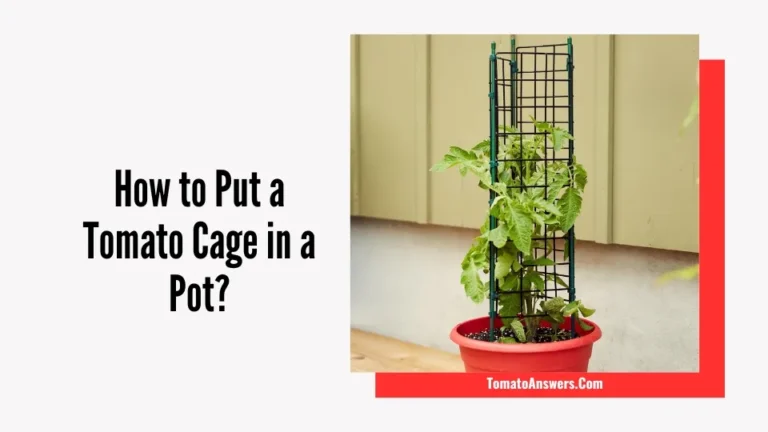In This Article
How to Put a Tomato Cage in a Pot?
Growing tomatoes in pots can be a great way to cultivate fresh tomatoes, even if you don’t have space for an entire garden. However, keeping the plants supported properly can be a challenge. A tomato cage is an excellent way to support and keep your potted tomato plants upright and healthy.
What is a Tomato Cage?
A tomato cage is a cylindrical or cone-shaped wire frame designed to support tomato plants as they grow. The cages are usually about 2-3 feet tall and made from sturdy wire that won’t bend easily under the weight of the tomato vines and fruit.
Tomato cages serve several essential functions:
- Provide physical support to keep plants upright
- Keep fruits off the ground, preventing rot
- Allow air circulation around the plant to discourage disease
- Make harvesting easier by keeping stems and leaves accessible
Types of Tomato Cages
There are a few main types of tomato cages:
- Wire Tomato Cages – These cages are made from wires bent into a cylindrical shape, often with vertical cables for extra support. They come in different heights for various-sized plants.
- Wooden Tomato Towers – These are open-ended enclosures wired together from wood slats. They allow easy access inside.
- Conical Tomato Cages – Cone-shaped cages are designed to take up less space while supporting plants.
- Ring Cages – These cages have a lower ring with vertical wires attached. They take up minimal space but still support plants.
Wire tomato cages are the most common and affordable for most home gardeners. The other types take up more room and tend to be more expensive.
Choosing the Right Size Cage for Pots
When selecting a tomato cage for a potted plant, you need to consider the size of the container. A cage with too large a diameter won’t provide adequate support. Follow this guide:
- For a 10-12 inch pot, use a cage with a 14-16 inch diameter
- For a 14-16 inch pot, choose an 18-24 inch diameter cage
- For an 18-24 inch pot, select a 24-30 inch diameter cage
The cage height should be about 2-3 feet tall, or at least 6 inches taller than the expected height of the variety you’re growing. This provides room for the entire plant to grow vertically.
For dwarf and patio-type tomato varieties, you can often use smaller 14-18 inch cages, even in larger pots, since the plants don’t get as tall.
Cage Materials
Tomato cages can be made from:
| Material | Description |
|---|---|
| Steel wire | It is durable and corrosion-resistant but can be prone to rust. Provides excellent support. |
| Vinyl coated wire | It prevents rust and is easy to see against plants. Usually green or black coating. |
| Wood | It’s an attractive option but more expensive and not as sturdy. Requires more maintenance. |
For outdoor use, steel or vinyl-coated wire cages are best. Indoors, wooden cages can add a nice decorative element.
How to Put a Tomato Cage in a Pot
Putting a cage in a potted tomato plant takes some forethought and technique. Follow these steps for proper setup and support.
When to Add the Cage
It’s best to add the tomato cage when planting or shortly after. Trying to add one later can disturb roots and damage the plant.
For newly planted seedlings:
- Fill the container most of the way with potting mix, leaving several inches from the top.
- Place the cage in the center and stabilize it by pressing the bottom into the soil.
- Plant the seedling in the center, inside the cage.
- Fill in around the plant with the remaining potting mix.
For established plants, gently lift the foliage enough to slip the cage over it and press it into the soil.
Securing the Cage Properly
To keep the cage securely in place:
- Push the bottom portion into the soil at least 2-3 inches so it won’t shift around.
- On larger pots, anchor the cage by crisscrossing plant ties or garden twine from the top ring over the soil surface to the bottom.
- You can also place a stake in the soil next to the outside of the cage and loosely tie the cage to it. Don’t drive stakes through the cage.
- Check cages regularly to ensure they are firmly set in the pot and not tilting. Push back down as needed.
- If using a cone-shaped cage, secure the wide top ring to wooden plant stakes in a few spots around the pot.
Caring for Plants in Cages
Follow these tips for growing healthy caged tomato plants:
- Gently tie main stems to the cage wires as they grow using plant ties, but avoid excessive binding.
- Prune away lower leaves or stems tangled in the cage to improve air circulation.
- Water should be used at the soil level rather than overhead to keep foliage dry and discourage disease.
- Rotate pots regularly so all sides get sunlight and even growth.
- Keep an eye out for pests like hornworms that can hide inside cages.
- Harvest by reaching through cage openings rather than disturbing the structure.
- At season end, gently lift the cage straight up and out before breaking down the plant.
Pros and Cons of Cages for Potted Tomatoes
Growing tomatoes in pots with cages has several notable benefits:
Pros:
- Prevents sprawling, tipping plants
- Keeps fruits clean and easy to harvest
- Maximizes vertical space for growth
- Can support multiple plants in large pots
- Allows airflow, which reduces disease
- Reusable for multiple seasons
- Provides easy access for pruning and care
- Less work than staking and tying vines
Cons:
- It can be prone to blowing over in windy spots
- Require more space than uncaged plants
- Fruits can get stuck inside a cage
- Can obstruct water flow when using drip irrigation
- We may need additional staking for tall plants
- Difficult to move once plant gets large
Alternative Support Options for Potted Tomatoes
While cages are the most popular option, here are a few other ways to support potted tomato plants:
- Plant stake trellising – Stakes and plant ties to create a teepee-like structure. Takes more effort than a cage.
- Twine wrapping – Wrapping vines loosely around the pot in a spiral pattern with twine or garden tape.
- Tomato rings – Bottomless wire rings around the base of plants offer minimal support.
- Cage clipping – Clipping part of a wire cage to fit over a smaller pot.
- Plant spirals – Decorative spirals staked into the pot that vines can grow around.
Most gardeners prefer the simplicity of tomato cages, but staking or trellising works, too. Just avoid letting potted tomato plants grow sprawling along the ground.
Tips for Growing Great Tomatoes in Containers
Beyond just adding cages, here are some tips for maximizing your potted tomato harvest:
- Choose compact tomato varieties bred for containers.
- Use large pots (at least 10″ diameter) and quality potting mix.
- Provide 5+ hours of direct sun daily.
- Use bottom trays to prevent drying out.
- Add mulch over the soil to retain moisture.
- Feed plants regularly with tomato fertilizer.
- Prune lower growth for good airflow.
- Check plants daily for pests and diseases.
- Stake or cage plants should be planted as soon as they are planted.
- Harvest ripe fruits promptly to encourage more production.
Growing tomatoes in pots provides a fun, space-saving way to enjoy homegrown tomatoes. Follow these guidelines for putting tomato cages in pots, and you’ll have happy, healthy, heavily-producing container tomato plants.
Frequently Asked Questions About Tomato Cages in Pots
Here are answers to some common questions about using tomato cages in potted plants:
How many tomato plants can you put in a pot with a cage?
For larger 24-30 inch diameter cages, you can plant 3-4 plants spaced evenly inside the circumference of the cage. Make sure to use a huge pot, fertilize regularly, and provide ample sunlight when growing multiple plants this way.
Should tomato cages be anchored into the ground?
For potted plants, there’s no ground to anchor cages in. However, stabilizing cages is still essential, as the bottom portion must be sunk deep into the soil and secured with ties around the pot.
Do I need to prune tomato plants in a cage?
It’s a good idea to prune off lower branches and leaves that grow outside the cage and get tangled. This improves airflow and makes the plant focus energy on the parts inside the cage instead.
What is the best way to water tomatoes in a pot with a cage?
Water at the base of the plant using a watering can spout inserted through the cage opening. Avoid splashing water on the leaves. Drip irrigation or self-watering pots also help provide steady moisture.
Should you rotate potted tomato plants in cages?
Rotating pots helps ensure even sun exposure for uniform growth. Just be sure to check that cages remain anchored firmly when turning plants. Consider rotating 1-2 times per week.
How do you remove tomato cages from pots at the end of the season?
When plants are finished producing, cut stems at soil level and gently lift the cage straight up and out of the pot. This avoids damaging the remaining rootball so the pot can be reused.
Can you use square cages instead of round ones in pots?
Round wire cages are best for fitting securely inside round pots. Square or rectangular cages can be used but may leave more open space for plants to escape from inside the cage.
What can I use if I don’t have a tomato cage for my potted plant?
Suitable substitutes include using wooden stakes and plant ties for a teepee-like trellis or wrapping flexible garden tape around the pot in a spiral shape for vines to follow.
And those are the key things to know about successfully using tomato cages with container-grown tomato plants! Let me know if you have any other questions.

